Introduction
Roadways and parking lots typically comprise about 70 percent of developed impervious surfaces. They provide multiple opportunities to incorporate Low Impact Development (LID) practices that disconnect impervious surfaces and reduce, filter and infiltrate runoff while still providing adequate access and parking. Low Impact Development practices such as bioretention basins in parking lot islands and roadway medians or porous pavement sidewalks can be incorporated into new developments or retrofitted into existing developments.
Low Impact Development is a sustainable approach to stormwater management that minimizes impacts on waterways by treating and infiltrating runoff from rainfall and snowmelt close to its source.
In some cases, the use of LID can result in decreased need for expensive underground stormwater infrastructure, resulting in a net decrease in cost. However, changes to local codes and ordinances are often needed to allow widespread use of LID in roadway and parking lot designs. For example, existing codes that require the use of impermeable asphalt or concrete should be revised to encourage the use of permeable pavement on sidewalks, alleys, roadway parking and overflow parking areas in parking lots.
Roadways
Increasing attention has been focused recently on “Green Streets,” or designs that meet multiple needs while capturing, treating and reducing stormwater runoff. Traditional storm drain system designs collect and concentrate flows and pollutants, delivering them to nearby waterways without allowing contact with vegetated areas that can filter and infiltrate runoff. LID designs recognize that stormwater can be a valuable resource.
By mimicking natural hydrology with functional landscaping designs and porous pavements, we can reduce pollution and decrease runoff rate, volume, pollutants and elevated temperatures, while adding aesthetic accents to the landscape.
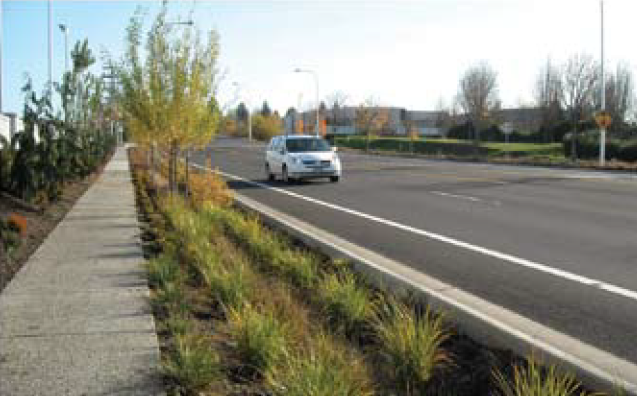
This roadside swale or bioretention basin receives and infiltrates water while providing attractive landscaping. The sidewalk made from porous concrete allows additional infiltration. Image by San Mateo County Sustainable Green Streets and Parking Lots Guidebook.
Use the following tips to reduce impervious surfaces and increase infiltration of runoff.
- Reduce the width of travel lanes to decrease impervious area. The extra space can be used for bioretention areas, and the narrower widths help slow traffic and reduce runoff.
- Use vegetated swales as alternatives to curbs and gutters. Typical street design standards generally call for curb and gutter to be directly connected to storm drain inlets. This concentrates stormwater and increases its velocity and volume. Instead, eliminate curbs or use curb cuts to route runoff into recessed vegetated roadside swales, where water can soak into the ground.
- Incorporate rain gardens or other bioretention features into roadway medians and the center of cul-de-sacs. Roadways can be sloped toward central bioretention features, and traditional curb and gutter eliminated. A 30-foot island at the center of an 80-foot diameter cul-de-sac reduces the amount of impervious surface by 15 percent while retaining a 25-foot road width. Curb cuts or rocks can be used to prevent travel into infiltration features.
- Design cul-de-sacs with reduced radii or T-shaped layouts. One-way loops or streets with parking on only one side can also be used to decrease the total amount of impervious surface.
- Reduce the size or number of on-street parking stalls. The extra space can be used for landscaped areas that allow stormwater infiltration. Porous pavement can also be used between parking stalls and for seldom-used parking spaces.
- Require parking on only one side of the street. This design works well in residential neighborhoods where most homes have off-street parking on driveways or in garages.
- Add curb extensions with bioretention basins. These are landscaped areas that extend into the street, as shown in the photo above. Curb extensions are commonly used for traffic calming, but can have added stormwater benefits if designed to allow runoff to drain into recessed landscaped areas. Curb extensions can easily be retrofitted into existing streets, if some on street parking is removed.
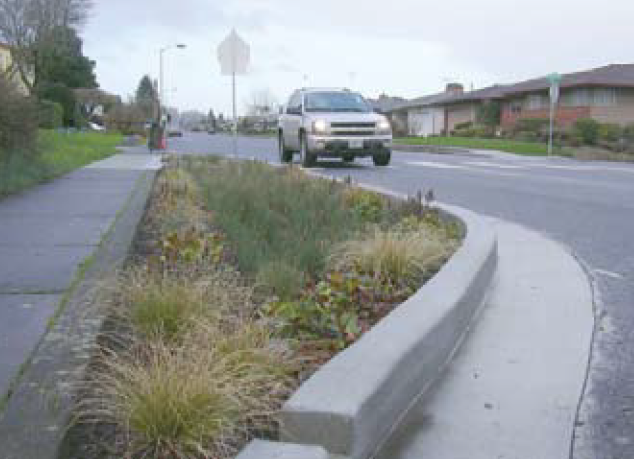
A mid-block curb extension collects stormwater runoff without requiring the removal of existing curb and gutter. Any overflow returns to the street. Image by San Mateo County Sustainable Green Streets and Parking Lots Guidebook.
Parking lots
Parking lots also provide numerous opportunities for bioretention and infiltration of stormwater without losing functionality. Consider the following tips:
- Shorten stall lengths or drive aisle widths. This frees up space for landscape infiltration and can also help improve pedestrian access. Most vehicles will fit within a 15-foot-long parking stall. Parking stall length requirements vary for each municipality. For example, Washoe County code requires 17-foot-long parking stalls.
- Plan for the amount of parking needed on an “average day,” rather than for the rare holiday shopping day. Consider opportunities for shared parking with adjacent businesses, particularly for those that are open only during part of the day or evening.
- Incorporate porous paving into the less-used parts of the parking lot. For example, use porous pavement, including grid pavers or porous asphalt or concrete, for outlying parking spaces that are seldom used. This design works best when planned in advance so larger areas of impermeable pavement can be graded to direct runoff to permeable pavement areas. Porous paving can also be incorporated into sidewalks, walkways and medians.
- Place swales at the edges of parking lots or between rows of parking stalls. The swales can incorporate required landscaping while also infiltrating runoff. If site soils are sandy and allow for infiltration, it may be possible to greatly decrease underground infrastructure, such as catch basins and storm drain pipes, providing a cost savings.
- Convert existing landscaping into stormwater facilities. Most parking lots incorporate landscaped islands that are raised and surrounded by curbs. These areas can be redesigned with recessed landscaping to serve as bioretention areas, with no net loss in usable space in the parking lot. Bioretention basins in parking lot islands should use drought-tolerant vegetation to reduce irrigation needs and rock borders or curb stops to control entrance by cars and pedestrians.
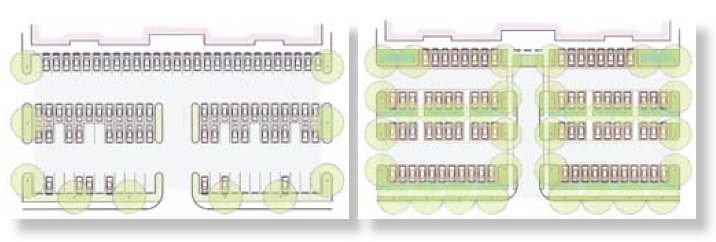
At left, a traditional parking lot design with unused spaces. At right, an LID parking lot design, incorporating 15-foot-long parking stalls and 22-foot-wide travel aisles. The LID design does not have as many parking spaces,but allows more landscape space for stormwater bioretention and infiltration and improves pedestrian circulation and safety. Image by San Mateo County Sustainable Green Streets and Parking Lots Guidebook.
Opportunities for LID in Streets and Parking Lots
- REDUCED IMPERVIOUS SURFACES from decreased street widths and parking stall lengths
- SHARED OR HOLLYWOOD DRIVEWAYS
- ALTERNATIVE DESIGNS for cul-de-sacs, bioretention islands and medians, roadside swales and bioretention basins, and bioretention curb extensions
- PERMEABLE PAVEMENT for sidewalks, alleys, roadway parking and overflow parking areas in parking lots
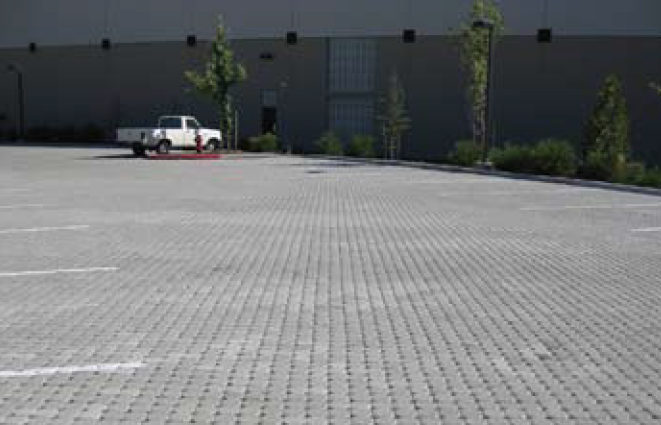
Porous pavement was installed in this commercial parking lot. Image by Melody Hefner.
For a description of various Low Impact Development practices
consult the following Fact Sheets in the “Low Impact Development in Northern Nevada” series:
- LID: An Introduction, FS-09-22
- Soil Considerations, FS-09-23
- Rainwater Harvesting, FS-09-24
- Bioretention, FS-09-25
- Vegetated Swales and Buffers, FS-09-26
- Green Roofs, FS-09-27
- Plant Materials, FS-09-28
- Porous Pavement, FS-09-29
- Roadway and Parking Lot Design, FS-09-30
- Maintenance, FS-09-31
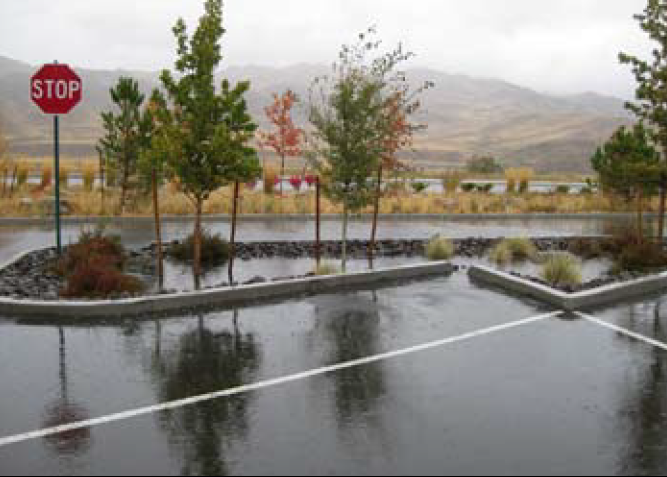
This parking lot island is designed to receive and infiltrate stormwater runoff from the parking lot. When the water-holding capacity of the island is exceeded, the water runs out the opposite side to a vegetated swale. Image by Melody Hefner.
Barriers to implementing LID on roadways and in parking lots
As mentioned earlier, local codes and ordinances can act as barriers to implementing LID. Emergency responders favor wide streets for access. Compromises in street widths can be made to allow infiltration while preserving emergency vehicle access. Current recommendations call for 24-foot road widths for most low-traffic roads. This width is sufficient for two-way traffic. The National Fire Protection Administration Uniform Fire Code (2003) recommends a minimum unobstructed width of only 20 feet.
LID practices that allow infiltration into underlying soils should not be incorporated into roads or parking lots where the risk from hazardous material spills is high, such as gas stations or chemical suppliers. Other unsuitable sites include areas with high or shallow water tables.
Maintenance workers are often reluctant to approve LID features due to concerns about the type or frequency of maintenance that will be needed. Curb and gutter is seen as a “tidier” solution requiring little maintenance, when in fact, regular cleaning of catch basins and storm drain pipes with specialized equipment is needed, as well as periodic reconstruction of curbs.
LID features such as bioretention basins typically require standard landscaping maintenance while porous pavements require annual street sweeping with vacuum type street sweepers.
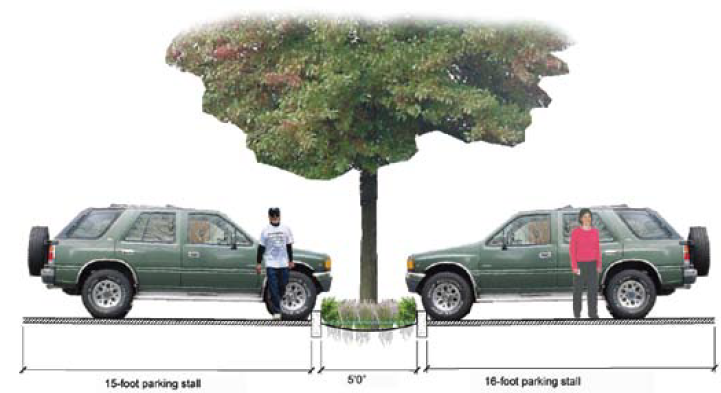
Place parking lot medians between rows of 15-foot parking stalls. Be sure to allow for pedestrian passage. Image by San Mateo County Sustainable Green Streets and Parking Lots Guidebook.
Reference:
San Mateo Countywide Water Pollution Prevention Program, 2009, San Mateo County Sustainable Green Streets and Parking Lots Design Guidebook, available at Flow to Bay
Technical review provided by Chris Conway, Certified Professional in Sediment and Erosion Control.
Additional information about LID roadway and parking lot design can be found at:
- Massachusetts Low Impact Development Toolkit, Roadways and Parking Lot Design, Fact Sheet #7
- U.S. Environmental Protection Agency, Managing Wet Weather with Green Infrastructure Municipal Handbook, EPA
- Massachusetts Nonpoint Source Pollution Management, Roadway and Parking Lot Design
- San Mateo Countywide Water Pollution Prevention Program, Sustainable Streets
Donaldson, S.
2009,
Low Impact Development in Northern Nevada: Roadway and Parking Lot Design,
Extension | University of Nevada, Reno, FS-09-30


